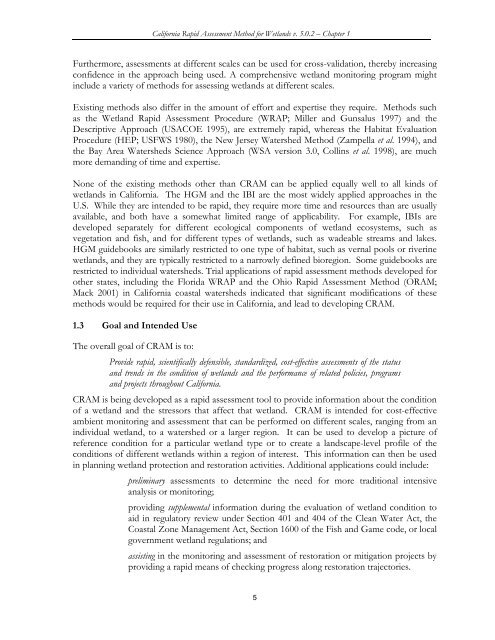(CRAM) For Wetlands User's Manual Version 5.0.2
(CRAM) For Wetlands User's Manual Version 5.0.2
(CRAM) For Wetlands User's Manual Version 5.0.2
You also want an ePaper? Increase the reach of your titles
YUMPU automatically turns print PDFs into web optimized ePapers that Google loves.
California Rapid Assessment Method for <strong>Wetlands</strong> v. <strong>5.0.2</strong> – Chapter 1<br />
Furthermore, assessments at different scales can be used for cross-validation, thereby increasing<br />
confidence in the approach being used. A comprehensive wetland monitoring program might<br />
include a variety of methods for assessing wetlands at different scales.<br />
Existing methods also differ in the amount of effort and expertise they require. Methods such<br />
as the Wetland Rapid Assessment Procedure (WRAP; Miller and Gunsalus 1997) and the<br />
Descriptive Approach (USACOE 1995), are extremely rapid, whereas the Habitat Evaluation<br />
Procedure (HEP; USFWS 1980), the New Jersey Watershed Method (Zampella et al. 1994), and<br />
the Bay Area Watersheds Science Approach (WSA version 3.0, Collins et al. 1998), are much<br />
more demanding of time and expertise.<br />
None of the existing methods other than <strong>CRAM</strong> can be applied equally well to all kinds of<br />
wetlands in California. The HGM and the IBI are the most widely applied approaches in the<br />
U.S. While they are intended to be rapid, they require more time and resources than are usually<br />
available, and both have a somewhat limited range of applicability. <strong>For</strong> example, IBIs are<br />
developed separately for different ecological components of wetland ecosystems, such as<br />
vegetation and fish, and for different types of wetlands, such as wadeable streams and lakes.<br />
HGM guidebooks are similarly restricted to one type of habitat, such as vernal pools or riverine<br />
wetlands, and they are typically restricted to a narrowly defined bioregion. Some guidebooks are<br />
restricted to individual watersheds. Trial applications of rapid assessment methods developed for<br />
other states, including the Florida WRAP and the Ohio Rapid Assessment Method (ORAM;<br />
Mack 2001) in California coastal watersheds indicated that significant modifications of these<br />
methods would be required for their use in California, and lead to developing <strong>CRAM</strong>.<br />
1.3 Goal and Intended Use<br />
The overall goal of <strong>CRAM</strong> is to:<br />
Provide rapid, scientifically defensible, standardized, cost-effective assessments of the status<br />
and trends in the condition of wetlands and the performance of related policies, programs<br />
and projects throughout California.<br />
<strong>CRAM</strong> is being developed as a rapid assessment tool to provide information about the condition<br />
of a wetland and the stressors that affect that wetland. <strong>CRAM</strong> is intended for cost-effective<br />
ambient monitoring and assessment that can be performed on different scales, ranging from an<br />
individual wetland, to a watershed or a larger region. It can be used to develop a picture of<br />
reference condition for a particular wetland type or to create a landscape-level profile of the<br />
conditions of different wetlands within a region of interest. This information can then be used<br />
in planning wetland protection and restoration activities. Additional applications could include:<br />
preliminary assessments to determine the need for more traditional intensive<br />
analysis or monitoring;<br />
providing supplemental information during the evaluation of wetland condition to<br />
aid in regulatory review under Section 401 and 404 of the Clean Water Act, the<br />
Coastal Zone Management Act, Section 1600 of the Fish and Game code, or local<br />
government wetland regulations; and<br />
assisting in the monitoring and assessment of restoration or mitigation projects by<br />
providing a rapid means of checking progress along restoration trajectories.<br />
5















